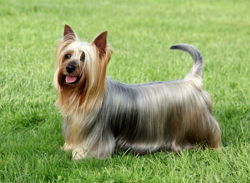Silky Terriers are toy dogs with lovely tan and blue coats. Their hair is straight, glossy, and silky, and it is long enough to fall below the body without reaching the floor. These dogs have profuse hair on the top of the head that can form a topknot. Their ears are small and V-shaped, their nose is black, and their eyes are dark, small and almond shaped. Silky Terriers measure 9 to 10 inches tall at the shoulder and weigh about 10 pounds.
Silky Terriers are intelligent, sassy, and sometimes stubborn dogs that need gentle and consistent training. Without it, these little dogs will end up ruling the household.
Friendly and adaptable, Silky Terriers make great pets for families and do well in most living situations. These dogs crave a lot of human attention, though, and will become unhappy if left alone for long periods. They also enjoy being active and need a walk and a game of fetch or play session outside every day. Silky Terriers are terriers to the core and will chase and kill rodents and other small animals.
When first developed in Australia, the Silky Terrier was known by the name Sydney Silky Terrier. In 1955, the breed's name was changed to Australian Silky Terrier in Australia and to Silky Terrier in the U.S. Despite all these names, many people called them Yorkshire Terriers or Australian Terriers, even though those are different breeds.
Highly alert dogs without natural shyness or nervousness, Silky Terriers are friendly and responsive and make good family companions. They are loving dogs and bond deeply with their human family members. Plus, their energy, inquisitiveness, and spunkiness make them fun to have around the house.
These dogs need attention, affection, and activity. They are confident, bold, and fearless, and they are very protective of their family and home. This protectiveness, when combined with their relentless bark, makes these dogs good watchdogs. Silky Terriers get along well with children, but these dogs prefer older kids to rough and unpredictable toddlers.
When given plenty of exercise in the form of daily walks, time in the yard, and play sessions with toys, these dogs remain happy, well behaved, and healthy. Although they can be exercised indoors when necessary, Silky Terriers benefit from time outside in a securely fenced yard.
Silky Terriers are a relatively healthy breed, but this is no guarantee that any individual dog will be free of health problems or genetic disease. Acquiring a puppy from a reputable source is a good first step in ensuring a healthy dog.
Intervertebral disc disease, patellar luxation, elbow dysplasia, Legg-Calve-Perthes disease, and tracheal collapse are all known to affect this dog breed. Diabetes and epilepsy are other major health concerns, but these conditions are usually treatable with continuing medication and professional care. Additionally, some Silky Terriers may develop certain eye conditions, some of which can lead to permanent blindness. These include cataracts and progressive retinal atrophy.
Routine veterinary care, proper nutrition, daily activity, and timely canine vaccinations help ensure Silky Terriers live a long and active life of 12 to 15 years.
Silky Terriers are intelligent, sassy, and sometimes stubborn dogs that need gentle and consistent training. Without it, these little dogs will end up ruling the household. The breed's cleverness, energy, and natural mischievousness must be channeled into productive activities to keep negative behaviors to a minimum.
Housetraining these dogs can be especially difficult. For this reason, it should start as early in life as possible. Another problem best dealt with early is the breed's tendency to nip and be possessive of food, toys, and special humans. This behavior should not be tolerated.
With consistent and repetitive training, a lot of attention and physical activity, and early socialization, Silky Terriers grow into tolerant, confident, and well-behaved adults. However, these terriers will always act like terriers and have the high energy levels commonly seen in terrier breeds. This should not be mistaken for disobedience.
Grooming the Silky Terrier takes a bit of time and energy. These dogs need daily brushing to prevent and remove tangles and mats and to distribute skin oils throughout the coat. A pin brush, metal comb, and soft slicker brush should be kept within reach, and a detangling spray can make brushing easier. Some trimming is also needed, and it may be necessary to tie long head hair into a bow to keep it out of the Silky's eyes.
These dogs need bathing every three or four weeks with a pH-balanced canine shampoo. Bathing more often may be necessary if the breed rolls around in something sticky, stinky, or toxic. A light trimming around the eyes, ears, and feet can make these dogs more comfortable.
To prevent snagging and breaking on carpet, the nails need clipping when they start to click on the floor. About once weekly, the ears should be cleaned with a veterinarian-approved otic cleanser and cotton balls and checked for signs of ear infection, such as odor, redness, or discharge. Daily toothbrushing is important to prevent foul breath, tooth decay, and periodontal disease.
Silky Terriers developed in Australia near the end of the 1800s. The breed was created by crossing Yorkshire Terriers from England with Australian Terriers. The resulting litters produced three distinct breeds, and the Silky Terriers were then bred together until there was a definitive type.
An organized standard was created in 1936 to prevent the Australian Terrier from additional crossbreeding with the Yorkie. Silky Terriers were known for many years as Sydney Silky Terriers, before the breed's name officially changed in 1955 to Australian Silky Terrier.
Also in 1955, the breed's name was changed to Silky Terrier in the United States. Soon thereafter, the breed was recognized by the AKC. Today, Silky Terriers are moderately popular and maintain low numbers in America. These dogs are primarily kept as companion animals by families.
The American Kennel Club officially recognized the Silky Terrier in 1959.

